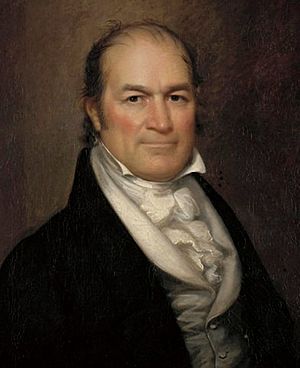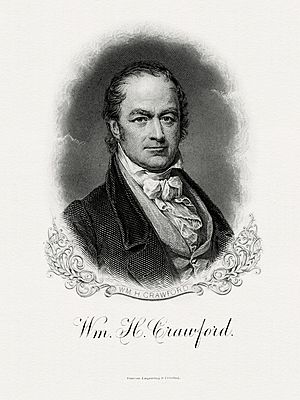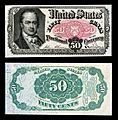William H. Crawford facts for kids
Quick facts for kids
William Crawford
|
|
|---|---|
 |
|
| 7th United States Secretary of the Treasury | |
| In office October 22, 1816 – March 6, 1825 |
|
| President | James Madison James Monroe John Quincy Adams |
| Preceded by | Alexander Dallas |
| Succeeded by | Richard Rush |
| 9th United States Secretary of War | |
| In office August 1, 1815 – October 22, 1816 |
|
| President | James Madison |
| Preceded by | James Monroe |
| Succeeded by | John C. Calhoun |
| United States Minister to France | |
| In office March 23, 1813 – August 1, 1815 |
|
| President | James Madison |
| Preceded by | Joel Barlow |
| Succeeded by | Albert Gallatin |
| President pro tempore of the United States Senate | |
| In office March 24, 1812 – March 23, 1813 |
|
| Preceded by | John Pope |
| Succeeded by | Joseph Varnum |
| United States Senator from Georgia |
|
| In office November 7, 1807 – March 23, 1813 |
|
| Preceded by | George Jones |
| Succeeded by | William Bulloch |
| Personal details | |
| Born |
William Harris Crawford
February 24, 1772 Amherst County, Virginia, British America |
| Died | September 15, 1834 (aged 62) Lexington Depot, Georgia, U.S. |
| Political party | Democratic-Republican (1803–1828) Democratic (1828–1834) |
| Spouse | Susanna Gerardine |
| Children | 7 |
William Harris Crawford (born February 24, 1772 – died September 15, 1834) was an American politician and judge. He lived in the early 1800s. He held important jobs like US Secretary of War and US Secretary of the Treasury. He even ran for US president in the 1824 election.
Crawford was born in Virginia but moved to Georgia when he was young. He studied law and became a lawyer. In 1803, he was elected to the Georgia House of Representatives. He was part of the Democratic-Republican Party.
In 1807, Georgia chose Crawford to be a US Senator. He became president pro tempore of the US Senate in 1812. This meant he was in charge of the Senate when the Vice President was not there. For a time, he was even next in line to become president.
In 1813, President James Madison made Crawford the US minister (like an ambassador) to France. He stayed there during the end of the War of 1812. After the war, Madison asked him to be the Secretary of War. Then, in 1816, he became the Secretary of the Treasury. He kept this job through the rest of Madison's time and all of James Monroe's presidency.
In 1823, Crawford became very sick. But he still wanted to be president in the 1824 election. Many people supported him, but his health was a big concern. The Democratic-Republican Party split into different groups. No candidate won enough votes to become president right away. So, the US House of Representatives had to choose. They picked John Quincy Adams, even though Andrew Jackson had more votes. Adams asked Crawford to stay as Treasury Secretary, but Crawford said no. He went back to Georgia and became a judge.
Contents
Early Life and Education
William Crawford was born on February 24, 1772, in Amherst County, Virginia. His parents were Joel Crawford and Fanny Harris. In 1779, his family moved to South Carolina. Then, in 1783, they moved to Columbia County, Georgia.
Crawford went to private schools in Georgia. He also studied at Richmond Academy in Augusta. After his father died, William had to help support his family. He worked on the family farm and taught at a school. Later, he studied law and became a lawyer in 1799. He started his law practice in Lexington.
Early Political Career
Crawford had a big impact on Georgia politics for many years. In 1803, he was elected to the Georgia House of Representatives. He served there until 1807. He was a member of the Democratic-Republican Party.
He became friends with Senator James Jackson. They had political rivals called the Clarkites. In 1806, Crawford was in a duel with John Clark. Crawford's left wrist was badly hurt, but he got better.
Serving in the US Senate
In 1807, Crawford became a US Senator for Georgia. He took the place of George Jones.
In March 1812, Crawford was chosen as the President pro tempore of the Senate. This meant he led the Senate meetings. When Vice President George Clinton died in April 1812, Crawford became the main leader of the Senate. He held this role until March 1813.
In 1811, President James Madison offered Crawford the job of Secretary of War. But Crawford turned it down. As a Senator, he supported going to war in the War of 1812. But he also wanted peace. He believed the nation should stay peaceful if it could.
Crawford was known for supporting states' rights in the Senate. He was part of the older, more traditional group of the Democratic-Republican Party.
Minister to France
In 1813, President James Madison appointed Crawford as the US minister to France. This was during the last years of Napoleon's rule in France. Crawford served in France until 1815. This was shortly after the Napoleonic Wars ended.
Cabinet Positions
When Crawford came back to the US, President Madison gave him a new job. On August 1, 1815, he became the Secretary of War. He worked in this position for over a year.
Crawford also tried to get the Democratic-Republican Party's nomination for president in 1816. He did not win, but it was a close race. On October 22, 1816, Madison appointed him Treasury Secretary. He kept this important job for the rest of Madison's time as president. He also stayed on as Treasury Secretary for both terms of President James Monroe. He left the job on March 6, 1825.
The 1824 Presidential Election
The Congressional Caucus chose Crawford as their candidate for the 1824 election. However, Crawford had a severe stroke in 1823. This made his health a big issue. The Democratic-Republican Party was divided into several groups.
Even though his health improved, and he had support from former Presidents Madison and Thomas Jefferson, he finished third in the election. Andrew Jackson, a hero from the Battle of New Orleans, and Secretary of State John Quincy Adams received more votes.
No candidate won a majority of the electoral votes. This meant the US House of Representatives had to choose the president. The House could only pick from the top three candidates. These were Andrew Jackson, John Quincy Adams, and Crawford. The House eventually chose Adams to be president.
Later Life and Legacy
After the election, President Adams asked Crawford to stay as Treasury Secretary. But Crawford said no. He returned to Georgia. There, he was appointed as a state superior court judge. Crawford continued to work as a judge until he died ten years later.
Crawford was considered for vice president in 1828 and 1832. He also thought about running for president again in 1832. But he decided not to when Andrew Jackson ran for a second term.
William Crawford is buried near his home in Georgia. His cousin, George W. Crawford, also became Secretary of War later on.
In 1875, William Crawford's picture appeared on the 50 cent bill.
Many places are named after him:
Cities and Towns
Counties
- Crawford County, Arkansas
- Crawford County, Georgia
- Crawford County, Illinois
- Crawford County, Indiana
- Crawford County, Iowa
- Crawford County, Michigan
- Crawford County, Missouri
- Crawford County, Wisconsin
Squares
- Crawford Square, Savannah, Georgia
Images for kids
See also
 In Spanish: William H. Crawford para niños
In Spanish: William H. Crawford para niños



